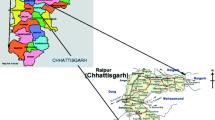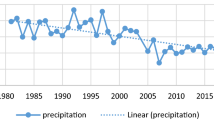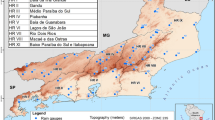Abstract
Rainfall and grain yield are two closely related random variables to be worthy of studying. The meteorological yield explains the influences of weather changes on grain yield. Based on the data series from 1980 to 2006 in Jinghuiqu irrigation district of Shaanxi Province in China, the meteorological yield is achieved from grain yield. Then, the empirical mode decomposition method is applied to analyze fluctuating periods and local features of rainfall and meteorological yield. Meanwhile, the copula method is introduced into describe the joint probability distribution of rainfall and meteorological yield. The studied results show that rainfall and meteorological yield exist vary fluctuation periods with multi-time scales, including 2 to 4 years of short period level, 4 to 6 (or 7) years of middle period level and 19 (or 10 to 11) years of long period level. Using the frank copula method, the bivariate distribution and return period of rainfall and meteorological yield was successfully developed to reveal the encounter risk of their different magnitudes. Finally, similarly with rainfall and meteorological yield, the complex changes and fluctuation periods are also proven to be existed in their joint probability.
















Similar content being viewed by others
References
Aggarwal PK, Mall RK (2002) Climate change and rice yields in diverse agro-environments of India. II. Effect of uncertainties in scenarios and crop models on impact assessment. Clim Chang 52:331–343
Budong Q, Reinder DJ, Jingyi Y et al (2011) Comparing simulated crop yields with observed and synthetic weather data. Agric For Meteorol 151:1781–1791
Bussel LG, Muller C, Keulen HV et al (2011) The effect of temporal aggregation of weather input data on crop growth models’ results. Agric For Meteorol 151:607–619
Cherubini U, Luciano E, Vecchiato W (2004) Copula methods in finance. Wiley, Chichesteer
Dimitrios AS, Albert R, Konstantinos T (2014) Evaluation of radiation-based reference evapotranspiration models under different Mediterranean climates in central Greece. Water Resour Manag 28:207–225
Goel NK, Kurothe RS, Mather BS, Vogel RM (2000) A derived flood frequency distribution for correlated rainfall intensity and duration. J Hydrol 228(1–2):56–67
Grimaldi S, Serinaldi F, Napolitano F et al (2005) A 3-copula function application for design hyetograph analysis. In: Proceedings of symposium S2 held during the Seventh IAHS Publ 293:203–211
Hao LSH, Li X, Li YY (2007) The wavelet analysis of solar activity variation. Arid Meteorol 24(4):34–45
Hatice C, Murat C, Tefaruk H, Qzgur K (2014) Estimation of monthly mean reference evapotranspiration in Turkey. Water Resour Manag 28:99–113
Hong CC (2009) The extreme cold anomaly over southeast Asia in February 2008: roles of ISO and ENSO. J Clim 3:23–35
Huang NE, Shen Z et al (1998) The empirical mode decomposition and the Hilbert spectrum for nonlinear and non-stationary time series analysis. Proc R Soc Lond A 454:903–995
Huang NE, Shen Z, Long SR et al (1999) A new view of nonlinear water waves: the Hilbert spectrum. Annu Rev Fluid Mech 31:417–457
James W, Andrew C (2013) The relative importance of rainfall, temperature and yield data for a regional-scale crop model. Agric For Meteorol 170(5):47–57
Jeffrey WW, Gerrit H, Bruce AK et al (2011) Methodologies for simulating impacts of climate change on crop production. Field Crop Res 124(3):357–368
Kesslar WS (2001) EOF representations of the Madden-Julian oscillation and its connection with ENSO. J Clim 3:12–23
Lin AIL, Li T, Li CHH et al (2011) Effects of air-sea interaction on the interannual oscillations of atmospheric boreal summer intraseasonnai oscillations over the tropical ocean. Acta Oceanol Sin 33(4):43–46
Liu JH, Guo YX, Qin DY et al (2011) Fluctuation of regional crop yield with extreme weather events: Winter wheat in Shijiazhuang. J Tsinghua Univ (Sci Technol) 51(6):777–782
Lobell DB, Field CB (2007) Global scale climate–crop yield relationships and the impacts of recent warming. Environ Res Lett 2:1–7
Madsen H, Mikkelsen RS, Rosbjerg D, Harremoes P (2002) Regional estimation of rainfall intensity-duration-frequency curve using generalized least square regression of partial duration series. Water Resour Res 38(11):34–38
Madsen H, Arnbjerg-Nielsen K, Mikkelsen PS (2009) Update of region intensity-duration-frequency curve in Denmark: tendency towards increased storm intensities. Atmos Res 92(3):343–349
Parry M, Rosenzweig C, Iglesias A, Fischer G, Livermore M (1999) Climate change and world food security: a new assessment. Glob Environ Chang 9:58–67
Pirjo PS, Lauri J, Miroslav T et al (2010) Coincidence of variation in yield and climate in Europe. Agric Ecosyst Environ 139(4):483–489
Rahimikhoob A, Behbahani M, Fakheri J (2012) An evaluation of four reference evapotranspiration models in a subtropical climate. Water Resour Manag 26(10):2867–2881
Shabri AB, Darud ZM, Ariff NM (2011) Regional analysis of annual maximum rainfall using TL-moments method. Theor Appl Climatol 20:1–10
Sheffield J, Goteti G, Wood EF (2006) Development of a 50-year high resolution global dataset of meteorological forcings for land surface modeling. J Clim 19:3088–3111
Sklar A (1959) Fonctions de repartition an dimensions et leurs marges. Publ Inst Stat Univ, Paris
Sommer R, Glazirina M, Yuldashev T et al (2013) Impact of climate change on wheat productivity in Central Asia. Agric Ecosyst Environ 178(15):78–99
Stewart EJ, Reed DW, Faulkner DS, Reynard NS (1999) The FORGEX method of rainfall growth estimation I: review of requirement. Hydrol Earth Syst Sci 3(2):187–195
Traore S, Guven A (2012) Regional-specific numerical models of evapotranspiration using gene-expression programming interface in Sahel. Water Resour Manag 26:4367–4380
Tu HW, Li ZHM, Luo GF et al (2009) Discuss and analyze of sunspot activity periods impact on the vary segment magnitude earthquake of west China. Prog Geophys 24(3):20–28
Wan Zin WZ, Jemian AA, Ibrahim K (2009a) The best fitting distribution of annual maximum rainfall in Peninsular Malaysia based on methods of L-moment and LQ-moment. Theor Appl Climatol 96(3):337–344
Wan Zin WZ, Jemian AA, Ibrahim K, Suhaila J, Sayang MD (2009b) A comparative study of extreme rainfall in Peninsular Malaysia: with reference to partial duration and annual extreme series. Sains Malaysiana 38(5):751–760
Wan Zin WZ, Jemian S, Deni SM, Jemain AA (2010) Recent changes in extreme rainfall events in Peninsular Malaysia: 1971–2005. Theor Appl Climatol 99(3):303–314
Yue S, Wang CY (2004) The Mann-Kendall test modified by effective sample size to detect trend in seriallycorrelated hydrological series. Water Resour Manag 18(3):201–218
Zhang JP, Ding ZHH (2013) Research on the lationship between rainfall and reference crop evapotranspiration with multi-time scales. Paddy Water Environ 11:473–482
Zhang DR, Xue CH (1994) Relationship between the El Nino and precipitation patterns in China since 1500 AD. J Appl Meteorol 5(2):168–175
Zhang JY, Li XQ, Zhang T (1999) The characteristics of weather yield for global crop and its relationship with precipitatiaon. J Appl Meteorol 10(3):327–332
Acknowledgments
This research is supported by the National Natural Sciences Foundation of China (Project No. 51309202, 51379216, 51379191, 51279183), and the Program for Innovative Research Team (in Science and Technology) in University of Henan Province (No. 13IRTSTHN030).
Author information
Authors and Affiliations
Corresponding author
Rights and permissions
About this article
Cite this article
Zhang, J., Zhao, Y. & Ding, Z. Research on the Relationships Between Rainfall and Meteorological Yield in Irrigation District. Water Resour Manage 28, 1689–1702 (2014). https://doi.org/10.1007/s11269-014-0577-3
Received:
Accepted:
Published:
Issue Date:
DOI: https://doi.org/10.1007/s11269-014-0577-3




